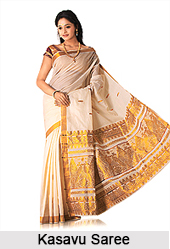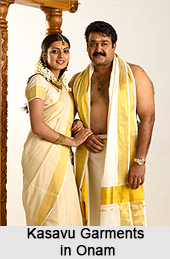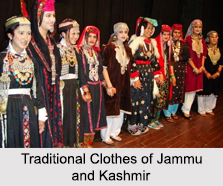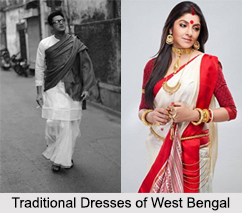 Kasavu Saree is a hand woven saree which emerges as one of the finest traditional sarees which define the essence of beauty of every woman in Kerala. The elegant Kerala Sarees, which are off -white in color with golden border is unique for their natural colour, texture and golden border. It is a handloom designed material which enhances its glamour through the intrinsic borders soaked in the colour of pure gold. This saree is considered to be the most auspicious attire for women in Kerela, especially during their Onam festival. The lovely Kasavu saree is also called the `Kerala Saree` or `Balarampur Saree`. Soft and comfortable to wear, this Kasavu saree can be an ideal day wear at a wedding. Mohiniattam, the traditional dance of Kerala is incomplete without the Kasavu look.
Kasavu Saree is a hand woven saree which emerges as one of the finest traditional sarees which define the essence of beauty of every woman in Kerala. The elegant Kerala Sarees, which are off -white in color with golden border is unique for their natural colour, texture and golden border. It is a handloom designed material which enhances its glamour through the intrinsic borders soaked in the colour of pure gold. This saree is considered to be the most auspicious attire for women in Kerela, especially during their Onam festival. The lovely Kasavu saree is also called the `Kerala Saree` or `Balarampur Saree`. Soft and comfortable to wear, this Kasavu saree can be an ideal day wear at a wedding. Mohiniattam, the traditional dance of Kerala is incomplete without the Kasavu look.
Design of Kasavu Saree
The typical Kasavu saree is hand woven and is 100 % unbleached cotton. The traditional design of a Kerala saree had a 1 inch to 6-7 inch pallu while the body remained plain. But now the pallu goes up to 1m and the border and pallu is decorated with variety of designs including that of peacock, flowers, and many more. The body of the saree is plain or with gold butis and the thin or medium thickness border is always gold. The price of an original Kerala saree is very much based on the quality of this "Kasavu" (Zari) Border and designs.
 Origin and History of Kasavu Saree
Origin and History of Kasavu Saree
Kerala Kasavu which was originally known as `Mundum Neryathum` traces itself way back to the Buddhist era. This attire was considered as a long piece of fabric which possessed a colored gold border that was displayed as a long garment and pinned onto to the left side of the shoulder. However, this attire till the 1970s was not worn as a typical sari, as the pallu was not considered as something that had to be draped as an upper garment. The Kasavu saree is made in Balarampur, a district in Kerala famous for its sugar mills and hence also sometimes called the Balarampur Saree.
Wearing Kasavu Saree
`Onam`, a festival that is widely celebrated in Kerala witnesses the beauty of Kasavu embroidered attires among the young and the older women especially while participating in their folk dances. Now, with the modern patterns and designs in these attires, it can be treated as a festive costume as well as an everyday outfit suiting ever occasion and season throughout the year. Traditional Gold jewellery with a reddish tinge goes well with this fabric.





















